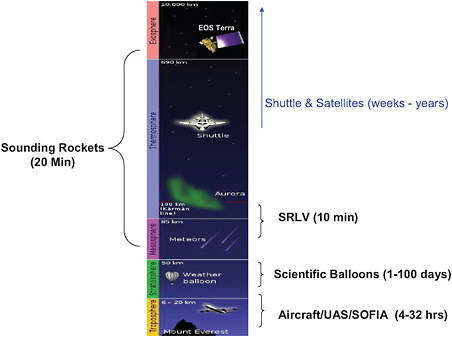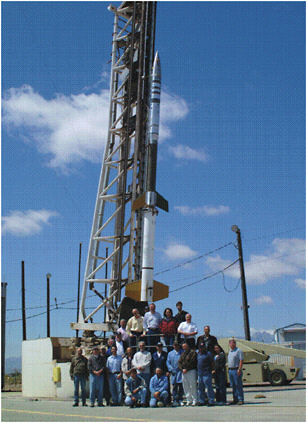1
Introduction
1.1
ORIGIN OF THE STUDY
The NASA Authorization Act of 2008 (Section 505) (see Appendix A) expressed the sense of Congress that suborbital flight activities, including the use of sounding rockets, aircraft, high-altitude balloons, and suborbital reusable launch vehicles, offer valuable opportunities to advance science, train the next generation of scientists and engineers, and provide opportunities for participants in the programs to acquire skills in systems engineering and systems integration that are critical to maintaining the nation’s leadership in space programs. The authorizing legislation from Congress stated that Congress believes that it is in the national interest to expand the size of NASA’s suborbital research program. It was further stated that funding for suborbital research activities should be considered part of the contribution of NASA to United States’ competitive and educational enhancement and should represent increased funding as contemplated in section 2001 of the America COMPETES Act (42 U.S.C. 16611(a)).
To assess the current state and potential of NASA’s suborbital research programs, the act directed NASA to enter into an arrangement with the National Academies to conduct a review of NASA’s capabilities in this area. At the request of NASA, the National Research Council (NRC) established the ad hoc Committee on NASA’s Suborbital Research Capabilities (biographies of the committee members appear in Appendix D) in January 2009. The committee was tasked with addressing the following topics: the existing programs that make use of suborbital flights; the status, capability, and availability of suborbital platforms and the infrastructure and workforce necessary to support them; existing or planned launch facilities for suborbital missions; and opportunities for scientific research, training, and educational collaboration in the conduct of suborbital missions by NASA (the statement of task is given in Appendix B).
The committee was asked to consider airborne platforms broadly and to include the Stratospheric Observatory for Infrared Astronomy (SOFIA), although it is not part of the suborbital program per se.
1.2
POLICY BACKGROUND
In 2007, the NASA associate administrator for the Science Mission Directorate chose to reinvigorate the suborbital program with additional funding. However, the increased funding was not sufficient to mitigate the problems that the suborbital program and NASA are facing.
The Council of Institutions of the Universities Space Research Association (USRA; a nonprofit corporation of 100 member universities and other research organizations involved in space science and technology) noted in a resolution in March 2007 a “decline in workforce development for space science and engineering brought on by the diminishment of hands-on, low-cost flight opportunities involving students” and cited the NRC report Issues Affecting the Future of the U.S. Space Science and Engineering Workforce (NRC, 2006), which stated that “NASA should expand and enhance agency-wide training and mentorship programs, including opportunities for developing hands-on experience, for its most vital required skills, such as systems engineering” (p. 4). In March 2008, the USRA resolved “that NASA budgets should reflect the historical precedent that at least 1 percent of NASA’s total budget be devoted to funding competitive opportunities for hands-on training provided by university missions on sounding rockets, high altitude balloons, remotely piloted vehicles, emerging commercial suborbital flights, and university class spaceflight missions.”
At its first and last meetings, the committee was briefed in closed session by Lennard Fisk and Joseph Alexander, respectively committee chair and study director of the NRC’s ad hoc Committee on the Role and Scope of Mission-Enabling Activities in NASA’s Space and Earth Science Missions, which recently released a report on the appropriate roles for mission-enabling activities and metrics for assessing their effectiveness. That committee also evaluated how, from a strategic perspective, decisions should be made about balance between mission-related and mission-enabling elements of the overall program as well as balance between various elements within the mission-enabling component.
1.3
TECHNICAL CONTEXT
Suborbital research began with balloon flights in the 18th century, which enabled atmospheric studies as well as Earth observation and even life sciences (the first passengers on the Montgolfier brothers’ 1783 balloon flight were a duck, a rooster, and a sheep). The inventions of the airplane and guided rocket in the early 20th century rapidly evolved into the sophisticated suborbital vehicles of today.
Research activities in fields such as Earth remote sensing and observation, atmospheric remote sensing and sampling, astronomy and astrophysics, heliophysics, and planetary sciences all have a wide range of requirements for suborbital platforms. These include access to different altitudes and latitudes, and different requirements for flight duration and payload mass. No single class of suborbital vehicle can satisfy these wide-ranging requirements (Figure 1.1).
In addition to its orbital spaceflight activities, NASA also conducts suborbital research using small rockets (known as sounding rockets; see Figure 1.2), high-altitude balloons, and aircraft, including high-altitude aircraft. All these assets support research in a number of disciplines, primarily solar and space physics, and Earth sciences (including upper-atmosphere measurements), astronomy, and astrophysics. Sounding rockets and aircraft can also be used to study short-duration microgravity effects.
NASA currently conducts approximately two dozen research-related sounding rocket launches each year, using a variety of rockets capable of carrying payloads ranging from 100 to several hundred kilograms, from altitudes of 100 to more than 1,000 kilometers. These rockets are launched from several locations around the globe depending on the mission requirements. Their payloads can sometimes be recovered. For several years NASA has evaluated the possibility of upgrading its fleet of sounding rockets to carry larger payloads on different flight profiles. Newly developed reusable launch vehicle technology may also offer promise for enabling new research.
In recent years, several small commercial spaceflight companies have emerged seeking to develop reusable suborbital launch vehicles capable of carrying passengers and possibly other payloads to altitudes of approximately 100 kilometers (the commonly accepted altitude at which Earth’s atmosphere ends and space begins). This technology is still immature, and the debut of these services is currently advertised as 2011 or 2012. However, they offer possible new opportunities for the research community.
NASA conducts flights of high-altitude balloons, often carrying large astronomical observatories. These balloons allow for long-term observations (lasting up to several weeks) and safe recovery of the payload. For example, the astronomy and astrophysics decadal survey report Astronomy and Astrophysics in the New Millennium (NRC,

FIGURE 1.1 Observing regimes accessible by suborbital vehicles. SOURCE: Adapted from Cheryl Yuhas, NASA, “Overview of the NASA Suborbital Program,” presentation to the Committee on NASA’s Suborbital Research Capabilities, May 20, 2009.
2001) included steerable ultralong-duration balloons as one of its prioritized initiatives. Balloon missions can involve international considerations regarding flyover permissions, launching, and payload recovery.
NASA operates several research aircraft capable of carrying a suite of instruments to various altitudes from locations around the world. Some of these aircraft can reach altitudes approximately twice that achieved by commercial airliners. Airborne observations are important for studies of the atmosphere, climate, storms, and Earth remote sensing. Included in the fleet are unmanned aircraft systems (UASs), which can stay aloft for long periods of time and can be used in riskier missions. NASA also operates a modified commercial airliner for astronaut training and microgravity research. Some airborne missions can involve international considerations regarding flyover permissions.
The committee was also asked to include in its study the Stratospheric Observatory for Infrared Astronomy (SOFIA). SOFIA is a modified Boeing 747SP aircraft with a 2.5-meter infrared telescope in a special compartment in the rear of the plane. The compartment can be opened at high altitude to provide an unobstructed view to permit astronomical observations above most of the atmosphere’s water-vapor. SOFIA will be able to observe at most wavelengths between 0.3 μm and 1.6 mm, which are not accessible from ground-based observatories. SOFIA’s telescope is not constrained to a fixed site or tied to the schedule of an Earth orbit and is capable of operating from locations around the globe at any time, which will enable observations of transient events. Researchers will conduct suborbital astronomy in a shirt-sleeve environment. In addition to its scientific capabilities, SOFIA has potential for training young instrumentalists and for testing technologies, such as novel instruments covering optical, infrared, and submillimeter bands. SOFIA is discussed further in Chapter 5.

FIGURE 1.2 Terrier-Orion rocket and launch team at White Sands Missile Range. SOURCE: NASA Sounding Rocket Program Office.
1.4
WORKFORCE ISSUES
Although the Solar and Space Physics Survey Committee recommended in its report, The Sun to the Earth—and Beyond: A Decadal Research Strategy in Solar and Space Physics (NRC, 2003), that NASA’s suborbital research program be reinvigorated, after a slight improvement the program continued to receive reduced budgets and conducted fewer flights. By 2007 NASA appeared to be proceeding on a path to discontinue this research.
In mid-2007 the NRC report Building a Better NASA Workforce: Meeting the Workforce Needs for the National Vision for Space Exploration (NRC, 2007) identified suborbital research programs as an important part of training for NASA and academic engineers and researchers. The report noted that because such programs allow those working on them to gain knowledge of many aspects of a project from start to finish, they are valuable in enabling their workforce to acquire systems engineering and program management skills, possibly including those necessary for NASA’s human spaceflight program. Small-scale experiments in suborbital research often serve as precursors to larger orbital missions and are important for training scientists and engineers to work on larger missions and for supporting the research base.




